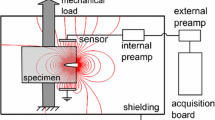Abstract
We study how the characteristics of electric signals emitted in the course of vibrations and fracture of ultrathin fibers under tension depend on the geometric parameters and physical properties of the fibers. A unique highly sensitive experimental plant was developed, and glass fibers of diameter 6.5, 10, 18, 150µm, as well as polyethylene fibers of thickness 0.2–0.06mm, were tested. It turned out that the signals emitted by fracture of fibers made of different dielectric materials (d < 20µm) are qualitatively the same in shape and have a negative phase of length 100–400µs and a much longer positive phase. An electric signal induced by a fiber thinner than a human hair by an order of magnitude was recorded for the first time. Unexpectedly, the average values of amplitudes of signals for fibers significantly different in diameter turned out to be close to each other. This can be explained by the well-known fact that the number of fragments in fracture increases with the glass strength (a scale effect). The potentialities of the method for measuring electric signals in studying the spectra of fiber vibrations were discovered.
Similar content being viewed by others
References
J. E. Caffyn and T. L. Goodfollew, “Electrical Effects Associated with the Mechanical Deformation of Single Crystals of Alkali Halides,” Nature 176(4488), 878–879 (1955).
A. A. Urusovskaya, “Electric Effects Associated with Plastic Deformation of Ionic Crystals,” Uspekhi Fiz. Nauk 96(1), 39–60 (1968). [Sov. Phys. Usp. (Engl. Transl.) 11 (5), 631–643 (1969)].
S. C. Langford and J. T. Dickinson, ASC/Symo. Ser. 415, 224–246 (1987).
Y. Enomoto and H. Hashimoto, “Emission of Charged Particles from Indentation Fracture of Rocks,” Nature 346(6285), 641–643 (1990).
J. Goldbaum, V. Frid, D. Bahat, and A. Rabinovich, “An Analysis of Complex Electromagnetic Radiation Signals Induced by Fracture,” Measurement Sci. Technol. 14, 1839–1844 (2003).
V. Frid, A. Rabinovich, and D. Bahat, “Fracture Induced Electromagnetic Radiation,” J. Phys. D: Appl. Phys., No. 13, 1620–1628 (2003).
V. N. Mineev and A. G. Ivanov, “Electromotive Force Produced by Shock Compression of a Substance,” Uspekhi Fiz. Nauk 119(1), 75–109 (1976). [Sov. Phys. Usp. (Engl. Transl.) 19 (5), 400–419 (1976)].
Yu. K. Bivin, V. V. Viktorov, and A. S. Chursin, “Electromagnetic Radiation under Mechanical Strain of Bodies,” in Annotations of Reports at 5th All-Union Conference in Theoretical and Applied Mechancis (Nauka, Alma-Ata, 1981) [in Russian].
Yu. K. Bivin, V.V. Viktorov, Yu. V. Kulinich, and A. S. Chursin, “Electromagnetic Radiation under Dynamical Strain of Different Materials,” Izv. Akad. Nauk SSSR. Mekh. Tverd. Tela, No. 1, 183–186 (1982) [Mech. Solids (Engl. Transl.)].
V. Ph. Zhuravlev, “Electromagnetic Radiation upon Collision of Solids,” Izv. Akad. Nauk SSSR. Mekh. Tverd. Tela, No. 6, 101–103 (1985) [Mech. Solids (Engl. Transl.) 20 (6), 101–104 (1985)].
E. A. Devyatkin, “Electron-Inertial Experiments with Impacting Rod,” Pis’ma Zh. Tekhn. Fiz. 16(3), 51–55 (1990) [Sov. Tech. Phys. Lett. (Engl. Transl.)].
E. A. Devyatkin, “On Electron-Inertial Experiment under Dynamical Strain of Conductors,” Pis’ma Zh. Tekhn. Fiz. 17(9), 6–11 (1991) [Sov. Tech. Phys. Lett. (Engl. Transl.)].
M. Ya. Balbachan and E. I. Parkhomenko, “Electret Effect during Rupture of Rocks,” Izv. Akad.Nauk SSSR. Fiz. Zemli, No. 8, 104–108 (1983) [Izv. Phys. Solid Earth (Engl. Transl.) 19, 661–665 (1983)].
A. Misra, “Electromagnetic Effects at the Metallic Fracture,” Nature 254(5496), 133–134 (1975).
A. Misra, “Theoretical Study of the Fracture Induced Magnetic Effects in Ferromagnetic Materials,” Phys. Lett. 62A(4), 234–236 (1977).
A. Misra, “Physical Model for the Stress-Induced Magnetic Effect in Metals,” Appl. Phys. 16(2), 195–199 (1978).
A. Misra and A. Kumar, “Some Basic Aspects of Electromagnetic Radiation during Crack Propagation in Metals,” Intern. J. Fract. 127(4), 387–401 (2004).
Yu. I. Novikov and F. I. Polovikov, “On Electric Charges Induced by Compression Strain in Polymetile metakrilate,” Fiz. Tverd. Tela 8(5), 1562–1568 (1966) [Sov. Phys. Solid State (Engl. Transl.) 8 (5), 1240 (1966)].
M. I. Molotskii, “Dislocation Mechanism of the Misra Effect,” Pis’ma Zh. Tekhn. Fiz. 6(1), 52–55 (1980) [Sov. Tech. Phys. Lett. (Engl. Transl.)].
V. M. Finkel, Yu. I. Golovin, V. E. Sereda, et al., “Electric Effects at Fracture of LiF Crystals in Connection with the Crack Control Problem,” Fiz. Tverd. Tela 17(3), 770–776 (1975) [Sov. Phys. Solid State (Engl. Transl.) 17 (3), 492–495 (1975)].
N. I. Gershenzon, D. O. Zilpimiani, P. V. Manguladze, et al., “Electromagnetic Radiation of the Crack Vertex during Fracture of Ion Crystals,” Dokl. Akad. Nauk SSSR 288(1), 75–78 (1986).
S. G. O’Keefe and D. V. Thiel, “A Mechanism for the Production of Electromagnetic Radiation during Fracture of Brittle Materials,” Phys. Earth and Planet. Interiors 89(1–2), 127–135 (1995).
O. I. Fal’kovskii, Technical Electrodynamics (Svyaz’, Moscow, 1978) [in Russian].
J. A. Stratton, Electromagnetic Theory (McGraw-Hill, New York, 1941; Gostekhizdat, Moscow-Leningrad, 1948).
J. Jackson, Classical Electrodynamics (Wiley, New York, 1962; Mir,Moscow, 1965).
J.W. Obreinov, “The Splitting Strength of Mica,” Proc. Roy. Soc. London Ser. A127(805), 290–297 (1930).
E. A. Devyatkin, “On the Possibility of Using the Electric Field Potential Variation Induced by Metal Strains to Estimate the Internal Stresses,” in Materials of 3rd All-Union Symposium “Technological Residual Stresses” (1988), pp. 142–146.
M. I. Miroshnichenko and V. S. Kuksenko, “Emission of Electromagnetic Pulses during Nucleation of Cracks in Solid Insulators,” Fiz. Tverd. Tela 22(5), 1531–1533 (1980). [Sov. Phys. Solid State (Engl. Transl.) 22 (5), 895–896 (1980)].
S. S. Solntsev and E.M. Morozov, Fracture of Glass (Mashinostroenie, Moscow, 1978) [in Russian].
Author information
Authors and Affiliations
Corresponding author
Additional information
Original Russian Text © E.A. Devyatkin, I.V. Simonov, A.A. Sirotin, 2009, published in Izvestiya Akademii Nauk. Mekhanika Tverdogo Tela, 2009, No. 1, pp. 154–164.
About this article
Cite this article
Devyatkin, E.A., Simonov, I.V. & Sirotin, A.A. On electromagnetic radiation under destruction of ultrathin glass fibers. Mech. Solids 44, 131–140 (2009). https://doi.org/10.3103/S0025654409010142
Received:
Published:
Issue Date:
DOI: https://doi.org/10.3103/S0025654409010142




